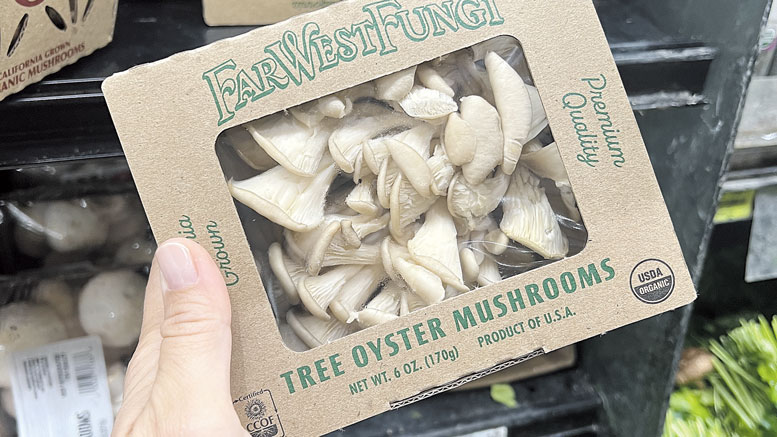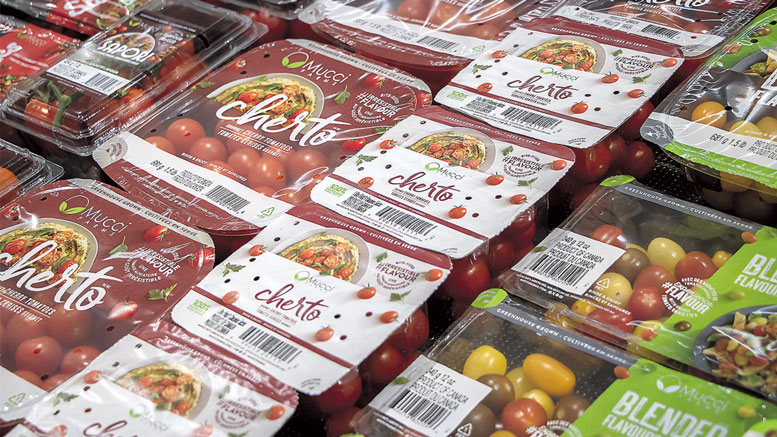The Art of Labeling and Bag Printing
June 25, 2024 | 8 min to read
Innovations in labeling, printing, and packaging are set to drive the produce industry forward. Companies like Sev-Rend and Jac. Vandenberg are prioritizing sustainable materials, such as bio-degradable pouches and cellulose netting from FSC-certified forests. Brands are adopting recycled content and improved labeling to enhance brand visibility and traceability, aligning with consumer values. Continuing efforts focus on reducing plastic, showcasing products attractively, and ensuring environmental responsibility in packaging solutions.

PHOTO COURTESY SAMBRAILO PACKAGING
Labeling, printing and packaging innovations will lead the industry into the future.
Originally printed in the June 2024 issue of Produce Business.
From clamshells and mesh bags to twist ties, the produce industry can label its packaging to convey key product information. Branding, marketing, QR codes — even grower and recycling information — are printed on labels.
Packaging Dive reports that, since 2020, several states have passed legislation related to minimum recycled content and extended producer responsibility (EPR) for packaging. Grocers, from large retail chains to smaller regional stores, are setting sustainability targets.
“Nearly every grocer is asking for 20% recycled content and a 15% reduction in virgin material by 2025,” says Mark Hoppenjans, vice president of sales and sustainable business for Sev-Rend in Collinsville, IL.
SUSTAINABLE PRODUCE PACKAGING
Sev-Rend produces flexible packaging, and develops new materials to meet market demand, such as Bio-Able pouches, which can biodegrade to zero microplastics, and PCR-Able packaging, made with 20 to 35% post-consumer recycled material (PCR).
“PCR-Able is a less expensive way to reduce virgin content and get within guidelines. It has good momentum, and will help things be less circular,” says Hoppenjans.
Tarrytown, NY-based Jac. Vandenberg has developed Packnatur, a cellulose netting made from beechwood recovered from FSC (Forest Stewardship Council) certified forests. The product was created in partnership with Austria-based manufacturer VPZ.
“We have been focused more on the holy grail of packaging, which is moving completely away from fossil-based materials like plastic and moving to nature-based that can be responsibility sourced from nature and reentered into nature at end of life,” says John Paap, brand and sustainability manager at Jac. Vandenberg.
The plastic-free alternative won “Best in Class” in Sustainable Package Design at the 2024 PAC Global Awards, as well as the U.S. Plastics Pact Award.
Villita Avocados, a third-generation grower, shipper and packer, has kicked off a 100% plastic-free bag, according to Rob Ybarra, executive vice president for avocados at Villita Avocados in Pharr, TX.
Organic avocados are in it now, and, by end of the year, it will be used for all of our avocados.”
The cellulose fiber yarn bag is made from eucalyptus wood from FSC-certified forests. The mesh bag can be composted in a backyard in three to six months.
The label, attached with a dry adhesive, is decorated in yellow, orange and green colors. The Villita brand name and social media information are displayed on the wrap-around label, as is the number of avocados.
INNOVATIVE LABELS AND LIDS
Mucci Farms grows, packs and ships greenhouse-grown produce in Kingsville, Ontario. It prioritizes packaging with greater potential for circularity, and has been successful with innovating solutions.
“One instance in particular is our award-winning, paper top seal package, which replaces the lidding film on standard top seal containers, with paper,” says Emily Murracas, director of marketing at Mucci Farms. “It has worked very well at retail and demand continues to grow.”

PHOTO COURTESY MUCCI FARMS
The lid label pictures tomatoes and appetizing prepared dishes. It seals to a PET tray. Paper Top Seal Reseal won a 2023 PAC Global Award of Distinction.
“Sustainability with regard to labels has been a real passion project of ours,” says Kristin Yerecic Scott, executive vice president of customer experience and administration at Yerecic Label in New Kensington, PA. “Labels can affect RPET (a recycled form of polyethylene terephthalate, which is a polymer used to make containers).”
Yerecic Label is developing an environmentally friendly label that is easily removed so the clamshell can be ground up.
THE RETURN OF PAPERBOARD
And then there is the option of washable adhesives and paper packaging.
Mucci Farms is exploring washable adhesives, experimenting with surface printing techniques using special inks, and finding ways to transition toward using more fiber, cardboard and paper packaging, says Murracas.
Sambrailo Packaging, which adopted the clamshell for the produce industry, has created a corrugated paperboard box called ReadyCycle. It is made from 30% post-consumer recycled fiber. The box, ink and adhesives are recyclable. A plastic film window is optional.
The ReadyCycle was first introduced to organic growers in California’s Pajaro Valley, says Sara Lozano, director of marketing and product development for Sambrailo Packaging in Watsonville, CA.
“When you look at our box, you know it’s cardboard, and you know you can recycle it. We wanted it to be intuitive to all users.”
ReadyCycle now packages mushrooms, strawberries and organic ginger root sold at nationwide chains.
PRINTING ON TAGS AND TIES
The industry is eliminating plastic packaging where possible, and following the 3 R’s of the environment: Reduce, Reuse, Recycle.
“The answer to these initiatives is a rubber band,” says Misty Smith, creative director at Alliance Rubber Company in Hot Springs, AR. “It is reusable, can be put on after harvest, and provides a firm hold for travel from point A to point B.”
Customers can select the color, width and stretchiness of a band, which is also customizable to include, for example, country of origin or a PLU code.
In keeping with the “less is more” idea for packaging, Bedford Industries manufactures Bib Ties, Produce Ties and Tag Ties for fresh produce, and CloseIt bag closures for bagged produce.
“Our tags/ties are normally custom printed with the grower’s logo, which is preferred by most retailers,” says Belinda Heidebrink, product marketing lead at Bedford Industries in Worthington, MN.
Bedford Industries’ ties can include farm-specific barcode/UPC, growing regions, and country-of-origin details for growers.
PRINTING ON BOXES, BAGS AND CLAMSHELLS
ReadyCycle, the corrugated paperboard box by Sambrailo Packaging, has printing capability on the top, bottom and sides.
“You can print 360 degrees, which is quite the departure from a clamshell, which has a top and bottom label,” says Lozano.
Yerecic Label prints a variety of produce labels, especially for clamshell containers. The labels can show branding, place of origin, and even a full recipe with a beautiful plate shot.
Sev-Rend produces its own SR-Film that uses less plastic and has a recyclable version. The thermal labels on SR-Film wrap around netted bagging. The branding is on the front of SR film.
“You can promote brands, such as for tangerines or apples. On the back, you can list where the product was grown and where it was packed,” says Hoppenjans of Sev-Rend.
Labeling and bag printing can be as detailed and specific as desired.
Jac. Vandenberg makes a compostable bag for its Sunrays grapes. The brand name, a smiling sun logo, the tagline “Snack with Impact,” and Save the Children (the charity they partner with) is splashed across the bag. At the bottom, a sustainability message is printed: “I’m not a regular plastic bag. I’m fully home compostable.”
BRAND MARKETING ON LABELS
Labeling and branding can pair up to excite the customer about what’s inside the produce package.
“On some level, there’s an emotional connection to brands, especially with younger consumers starting households. This group grew up with e-commerce and social media. They want a great product, along with data and the narrative of the brand. They want the product to align with their values,” says Hoppenjans.
Ties and tags can serve as mini billboards, with farm logos, brand colors and graphics. Bands have room for key information as well.
THE IMPORTANCE OF TRACEABILITY
Traceability continues to be important in the produce industry, particularly with the FDA’s updated Food Safety Modernization Act (FSMA). By printing a QR code or Digimarc digital watermarking, suppliers can include detailed product information without cluttering the label.
“We can trace the product back to the grower, with whatever program the grower is set up for,” says Scott. A printed QR code or website link can communicate information including traceability.
“Thermal and non-thermal labels on our SR Film are getting much more origin data than before. Like sustainability, traceability in the food supply is only increasing,” says Hoppenjans.
HEADING INTO THE FUTURE
Innovation will lead the produce industry into the future. Witness the new types of tags, ties, packaging and labels that continue to be developed.
Sev-Rend produces the Wineglass Tag, an industry favorite with exceptional print quality and eco-friendly versions. It is found on bags of oranges, potatoes, garlic and more. Its new Clip-to-Clip Tag serves as a bag handle, and comes shaped like an apple, onion or other produce item.
At Bedford Industries, during the last year, engineers have been making final design improvements to the Tag Tyer, Bedford’s machine that semi-automatically applies Tag Ties to fresh produce in the field or packing shed.
Moreover, Bedford has found a way to recycle its ties and tags. The company instituted the TagBack program, and has collected more than 215,000 pounds of returns since its launch four years ago.
Last year, the company launched PolyScape by Bedford, which creates upcycled plastic lumber from TagBack returns and other internal waste.
2 of 16 article in Produce Business June 2024

